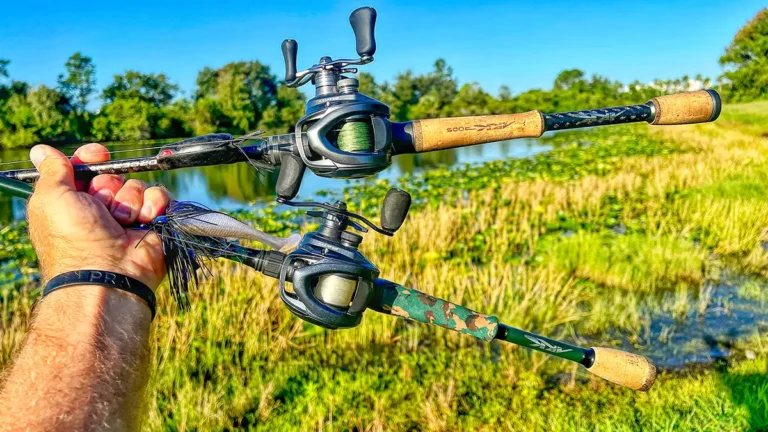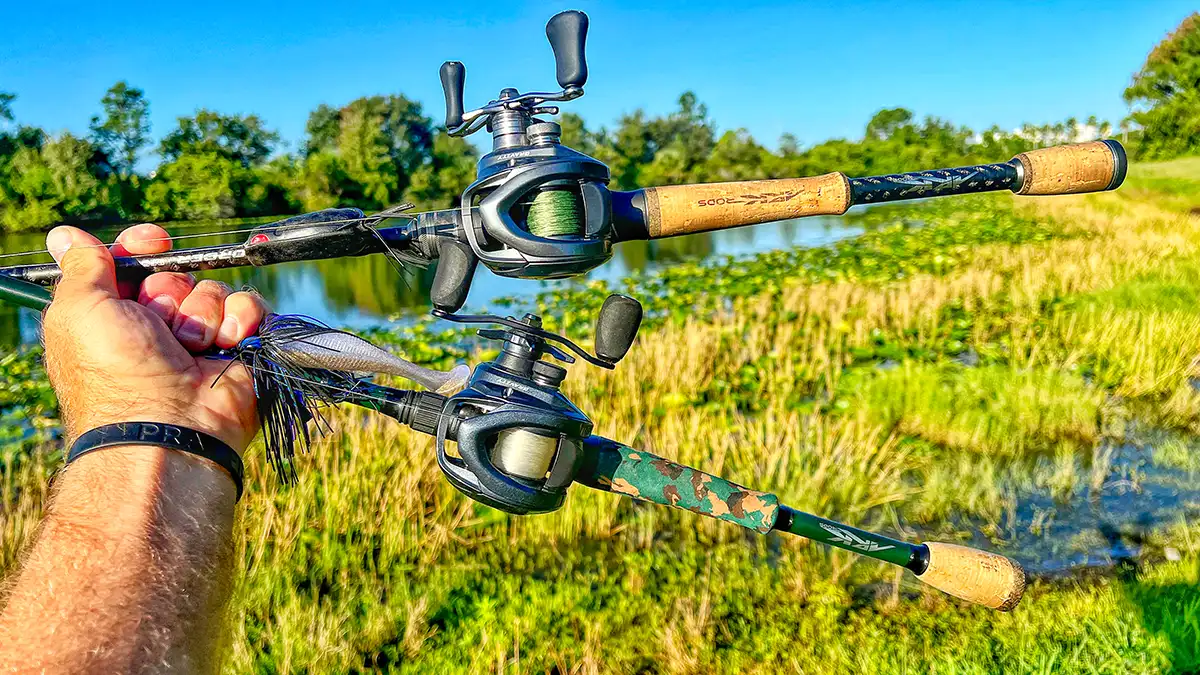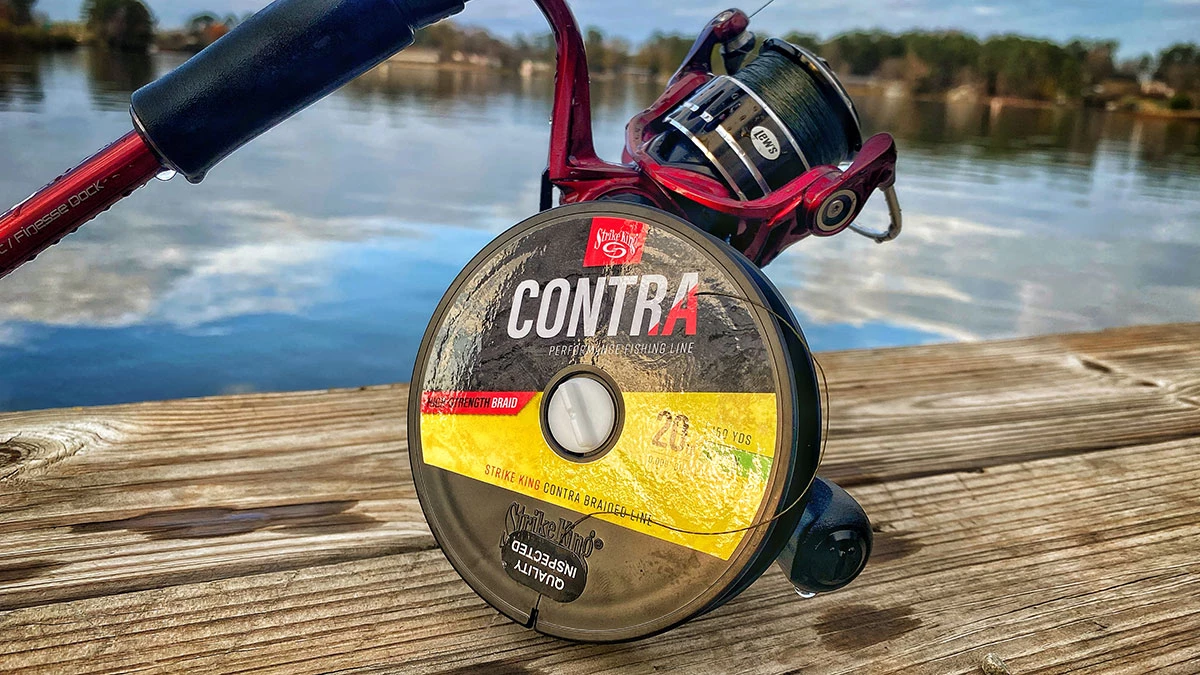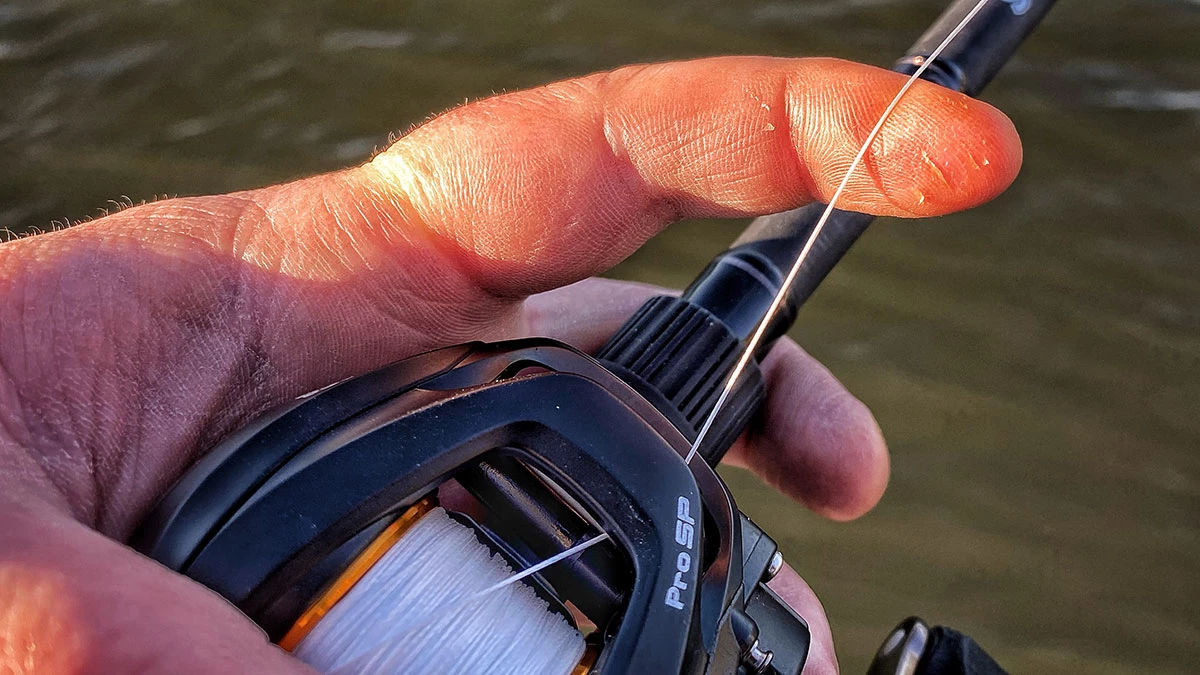There’s a fairly wide spectrum of fishing lines that work well with baitcasters. There are certainly some lines too though that will not work with baitcasting gear. The goal today is to simplify the process of picking out fishing line for your baitcaster, and hopefully eliminate some lessons that would otherwise be learned the hard way.
It’s fair to say that 95% or more of today’s bass fishing techniques work best paired with one of two line types: braided fishing line or fluorocarbon fishing line. These two line types offer something for almost every application. Traditional monofilament fishing line is serviceable in certain situations. And there are some hybrid, copolymer lines. We’ll talk about these a little too. But, again in the interest of simplifying the conversation, we’ll focus mostly on braid and fluoro.

WHY FLUOROCARBON FOR BAITCASTERS
Seaguar was the first to introduce the fishing world to this newest type of fishing line in 1971. Since then, fluorocarbon, or fluoro, has established itself as the most versatile fishing line in all of bass fishing. There are some things, however, it can’t do, namely float. Fluoro naturally sinks, so using this line with topwater baits is counterproductive. In those situations, you’ll want to use braid or mono, since these two line types are buoyant.
But for almost all subsurface techniques, especially those fished in clearer water, fluorocarbon reigns supreme. Fluoro is transparent, making it all but invisible beneath the surface. It is strong and abrasion resistant, making it great for targeting big fish around sparse and isolated cover. And though it has a little more stretch than braided line, it has far less than monofilament.
Let’s look at an example. The low stretch, transparency, strength, abrasion resistance and the fact that it sinks makes fluoro a great selection when fishing a football jig with a big single hook out in deeper, clear water along a rocky bottom. All fluoro isn’t created equal however. You have to make sure in this situation that the pound test is adequate for the application.
For instance, 17-pound Seaguar InvizX would be a great choice here, while 10-pound test would be far too weak and likely break on the hookset or the rocks. And 25-pound test would have too large of a diameter, limiting the amount of line you could spool on your reel.
Pound test and diameter directly correlate to one another. The larger the diameter, the stronger the line. But the larger the diameter, the less line you’ll be able to put on your reel too. This relegates fluoro larger that 20-pound test to very few techniques, like flipping shallow trees in clear water for instance. In this situation, you wouldn’t need a lot of line on your baitcaster, since you’re making short pitches. But the strength and low visibility of the heavy fluoro would be essential for getting bites and getting them out of the cover.
On the lighter side, anything south of 10-pound test usually doesn’t have a place in bass fishing with a baitcaster. This size line is meant more for use as a leader with a spinning reel. You could use 10-pound-test fluoro with a jerkbait on a baitcaster; perhaps with a fitness crankbait as well. But by and large, 12-pound test fluoro is the lightest line you’ll use with a baitcaster. This size line works really well with deep cranking for instance, since the smaller diameter cuts through the water better than a larger diameter line would, allowing the bait to dive deeper.
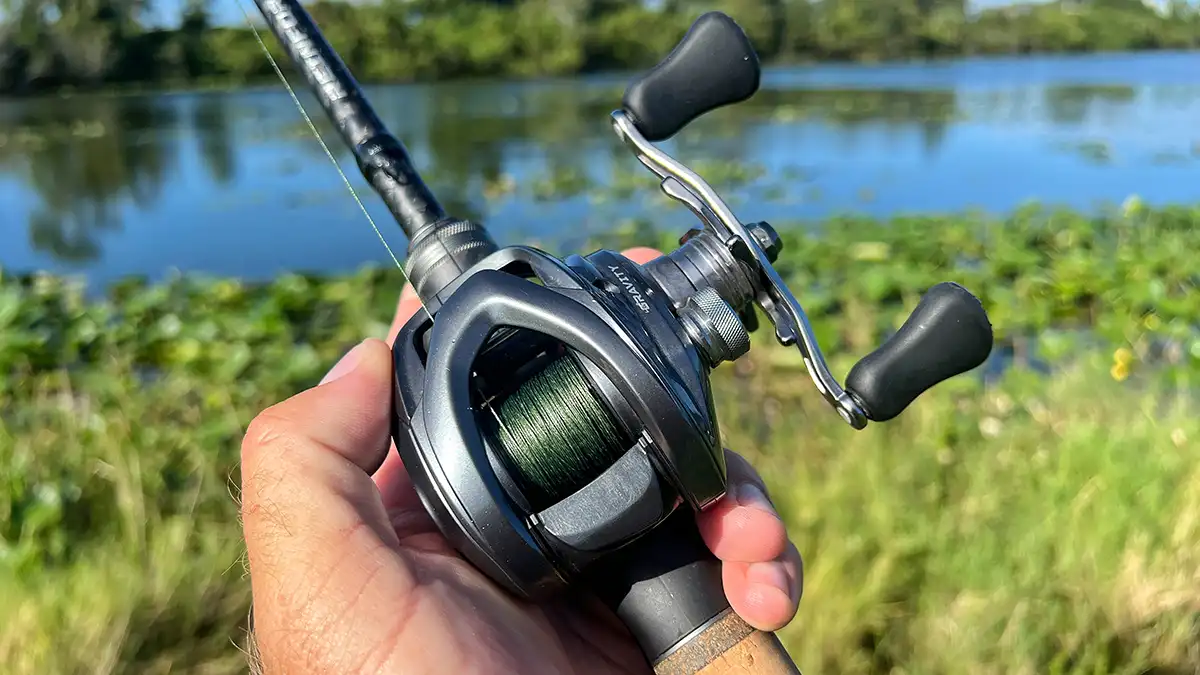
WHY BRAID WORKS FOR BAITCASTING REELS
Shifting the conversation over to braided line, this is when you start talking about the workhorse of baitcasting line. Braid is almost always the right choice around dense vegetation. There is no other option for punching for instance, when using a heavy tungsten weight to get your bait beneath a thick canopy of matted vegetation.
Braid is also the smartest selection (if not the only option) when talking about fishing a hollow body frog, ripping a lipless crankbait through submerged vegetation, fishing a spinnerbait through dense woody cover, and more. Braid is highly visible, but anytime you’re fishing around thick vegetation, the general belief is that it blends in well with the strands of vegetation.
Other situations, like when fishing a buzzbait for instance, can be a gray area. Fluoro is a bad idea for a buzzbait, as you’ll have to fight the line to keep the bait on the surface. Monofilament could work since it floats, and this makes for a decent selection, especially if money is an issue since monofilament is by far the cheapest of these lines. But the stretch of mono can make it hard to get a good hookup on a long cast. This makes braid the best option for a buzzbait most of the time, especially around cover.
Topwaters in general are an area where the conversation is divided. Baits like walkers and poppers do work with monofilament, and the stretch of the mono can even be a good thing when fishing these baits in close quarters, as the low stretch of braid can actually tear the small treble hooks of these baits out of short-striking bass.
However, when it comes to making long casts, the braid far outpaces mono. This is because the diameter of braid is much smaller, as compared to the same pound test in mono. This allows an angler to pack a lot more braid on a baitcaster, which directly results in the ability to make longer casts.
Braid is the most sensitive, strongest and has the lowest stretch of all these lines. If you’re a fan of braid, muddy water and vegetation are your friends. In vegetation, braid again provides more strength and even gives you the ability to cut through the vegetation better than fluoro. And in muddy water, when braid or fluoro could work, the low visibility of fluoro becomes less necessary. The mud essentially hides the braid. So in these situations, you can now use braid with subsurface baits like spinnerbaits, vibrating jigs, flipping jigs and the like, if you prefer.
A few words of caution though come along with braid and baitcasters. Braided lines smaller than 30-pound test really don’t work well with most baitcasters. These lines have very small diameters and will “dig in” or basically cinch down into the reel anytime you set the hook or get a backlash. Mentioning backlashes, these can be far more prevalent and severe with braid, especially early on.
It’s a good idea to tighten down your spool tension knob and braking system if you’re learning to fish with braid. Then loosen them up slowly to increase your range as you become more comfortable. We put together this piece a while back on how to setup a baitcaster if you’d like more info on that. And Sufix 832 Braid is a fantastic line choice for beginners, as well as seasoned anglers.
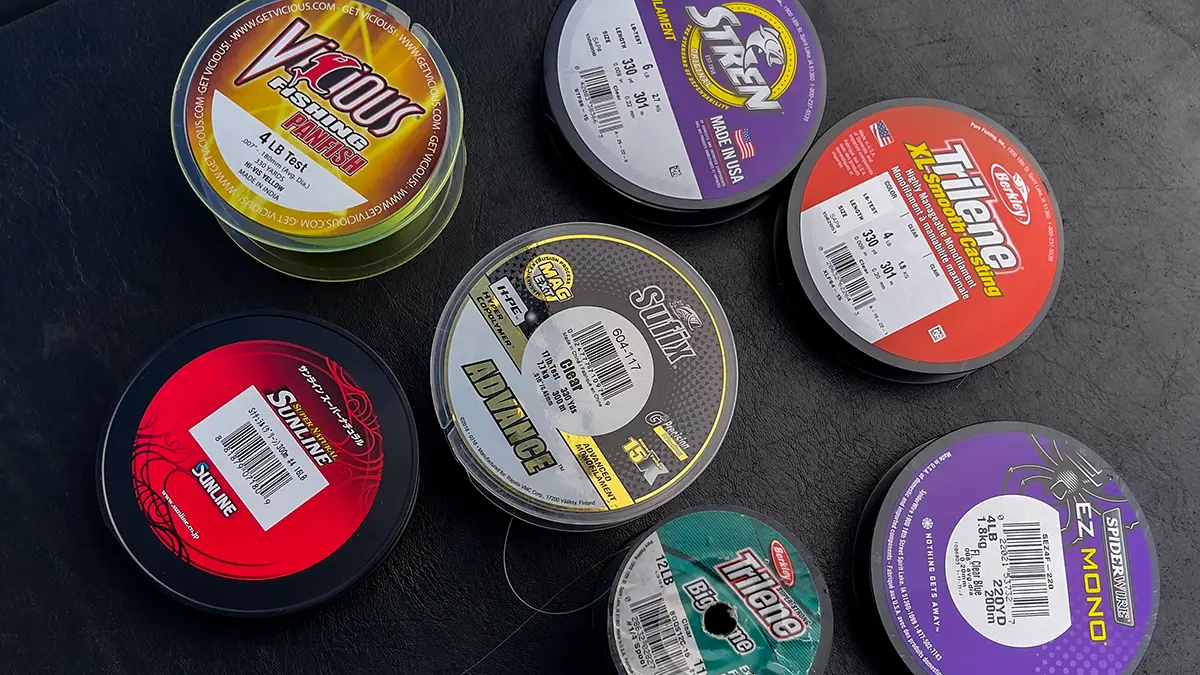
MONOFILAMENT LINES CAN WORK AS WELL
We’ve talked a little off and on about situations when monofilament line can work well with a baitcaster. To recap, the fact that mono floats makes it a decent selection for some topwater applications. But the larger diameter of this line type limits the amount you can spool on your reel, thus limiting the range of your presentation. And with big single hook baits, the stretch in mono makes it hard to hook a bass.
The affordability of mono is the best thing it has going for it, along with the fact that it’s fairly transparent. This low-vis characteristic and its affordability make it a decent alternative to fluorocarbon with some subsurface treble hook baits. But in the last couple years, there have been some fantastic affordable fluorocarbon lines introduced to the market, Seaguar BasiX being the first to come to mind. This line is available in spools of 12-, 15- and 20- pound test for $20 a spool, with enough line to spool a couple baitcasters, if you use backing.
Mentioning “backing”, this is a great use for monofilament line. Most baitcasters have deep spools with the capacity to hold far more line than would ever be needed to make a cast. So you can use cheaper monofilament line to take up some of this space closest to the spool to keep you from filling the whole spool with the more expensive braid or fluoro, which would never see the light of day.
For a quick example, let’s take a 200-yard spool of 12-pound Seaguar InvizX and a Lew’s Super Duty Speed Spool, which has a listed line capacity of 12/150 (which means it will hold approximately 150 yards of 12-pound line).
*Side note, most reel manufacturers use monofilament lines in their capacity ratings, since this was the most widely used line back when this system was set up. When looking at comparable pound test lines though, mono has a slightly larger diameter than fluoro. So in the above example, this reel could hold roughy 190 yards of 12-pound fluorocarbon.
We’re getting off in the weeds a little here. All this to say, using a 200-yard spool of 12-pound InvizX to completely fill this Speed Spool would be a huge waste of line and money. Instead, fill the spool of the reel halfway with cheap mono and then tie a connector knot between the mono and fluoro and finish filling the spool with the 12-pound InvizX. Fifteen-pound mono makes for a good backing and the goal is to have enough fluoro or braid on the reel that you’ll never cast all the way down to where you can feel the connector knot. A good rule of thumb, you should be able to spool two baitcasters with one 200-yard spool of line and be able to retie several times before ever casting down to the knot.
COPOLYMER LINES FOR BAITCASTERS
Copolymer line is the last and least used of the main types of line for bass fishing. This line is basically a good mix of the characteristics found in fluorocarbon and monofilament. It has less stretch than mono, but a little more than fluorocarbon. Most copolymer lines have a near neutral buoyancy, allowing them to hover in the water column.
This creates a better line of contact between the angler and the bait, since fluoro sinks and creates a downward bow in the line and mono floats creating an upward bow. Copolymer lines have a little better knot strength than mono, they’re more abrasion resistant and they’re a little harder to see in the water.
Though copolymer lines are certainly the least used of these four we’ve discussed today, there are some niche situations where they are the perfect blend to use with a baitcaster. Take glide baits for example. These large baits are designed to swim within a few feet of the surface, typically in relatively clear water. Bass often swipe at these baits and rarely eat them all the way.
The low stretch and higher sensitivity of fluorocarbon can lead to a premature hookset and the tearing loose of hair-lipped or skin-hooked fish. The slightly spongier and less sensitive copolymer line might allow the bass to get a better shot at the bait and, in effect, hook itself on the dangling treble hooks before the angler is even aware of the bass’s presence. This eliminates operator error and keeps the trigger-happy angler from snatching the bait away from the bass at the last second.
These same characteristics make copolymer line a decent choice of other treble hook baits, spinnerbaits, swimbaits and other subsurface presentations that could benefit from the bass having another second or two to connect with the bait. But by and large, the benefits of this line don’t really prop it up well against fluorocarbon or braided line.

MORE THOUGHTS ON FISHING LINES FOR BAITCASTERS
When it comes to the right line to use with a baitcasting reel, the conversation can get pretty deep. To keep it simple, monofilament makes for a decent selection with a baitcaster if you’re testing the waters of bass fishing. But as you really start to develop as an angler, you’ll want to transition to either braided line or fluorocarbon. Braid works well in low-visibility situations and in dense cover. It also floats, where fluoro sinks, so it will always be the better of the two with topwaters.
Fluoro is the clear choice when fishing subsurface— double entendre intended. The transparency of this line type makes it much harder for bass to see under the water as compared to braid. There’s almost no situation when braid is better than fluoro for bottom-dwelling baits like jigs. And most subsurface treble hook baits will perform better with fluoro, since this line sinks and has a little more give than braid.
Copolymer lines have their place, as do monofilaments. But as we stated at the onset you should focus most of your efforts on braid and fluoro when really dialing in your line selection for baitcasters. If you do this, and do it well, you’ll have a dynamic arsenal of baitcasting gear perfectly suited for a wide variety of applications.
For suggestions on the best individual lines for fishing, check out our various fishing line guides:
- Best Braided Fishing Lines
- Best Fluorocarbon Fishing Lines
- Best Monofilament Fishing Lines
- Best Fishing Lines




